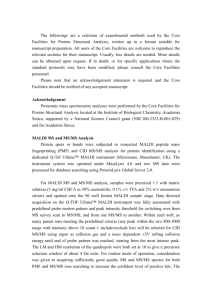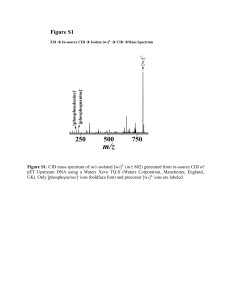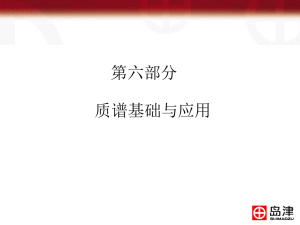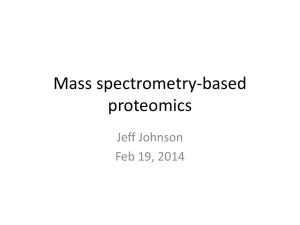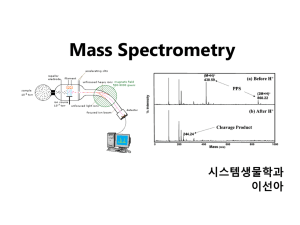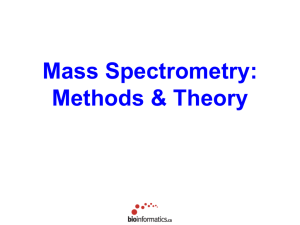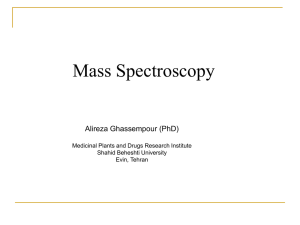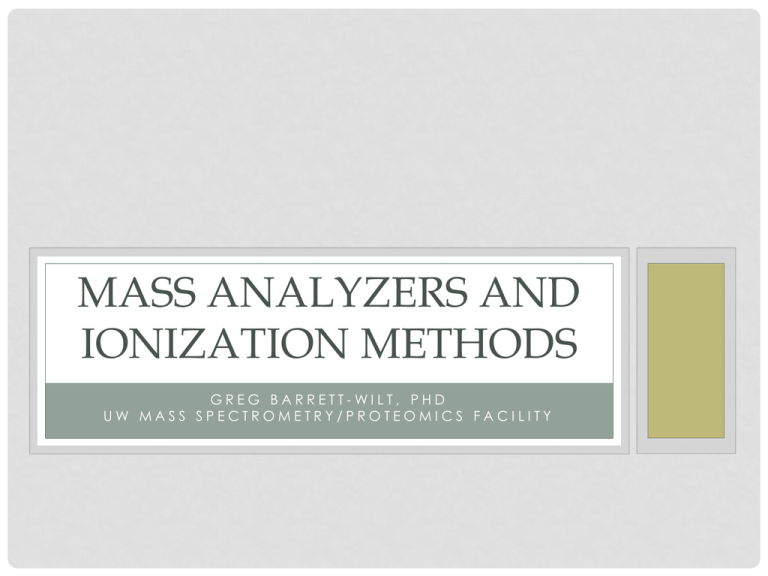
MASS ANALYZERS AND
IONIZATION METHODS
GREG BARRETT-WILT, PHD
UW MASS SPECTROMETRY/PROTEOMICS FACILITY
CENTRAL COMPONENTS OF A MASS
SPECTROMETER
Ionization source
Mass analyzer/filter
Detector
Vacuum chamber
To perform mass spectrometry two things are required:
1. The analyte must be an ion
2. The analyte must be in the gas phase
IONIZATION METHODS
ELECTRON IMPACT IONIZATION (EI)
“Hard” ionization method – ionization
and fragmentation occur
simultaneously
Incompatible with liquid streams
Widely used with gas
chromatography
Very standardized method:
70eV electron energy
NIST database
ELECTRON IMPACT IONIZATION (EI)
http://www.chromacademy.com/essential-guide/nov2010/fig-1.jpg
Wiley Registry of 638,000 compounds
(>700,000 spectra)
NIST Library: 242,477 compounds
Fred McLafferty
CHEMICAL IONIZATION (CI)
“Softer” ionization method – observation of
intact molecular ions possible
EI source filled with gas (N2, methane,
ammonia) yields ionized gas molecules
Reagent gas ions ionize analytes
Primary ion formation
CH4 + e- → CH4+ + 2eSecondary reagent ions
CH4 + CH4+ → CH5+ + CH3
CH4 + CH3+ → C2H5+ + H2
Product ion formation
M + CH5+ → CH4 + [M+H]+ (protonation)
[M+H]+
MATRIX ASSISTED LASER DESORPTION
IONIZATION (MALDI )
“Soft” ionization method: preserves the intact analyte
UV absorbing matrix is energized by the laser
Matrix molecules desorbed from the surface
carry analyte molecules into the gas phase
Proton transfer from matrix (acid) to analyte in
the gas phase
UV laser used to generate ions:
N2 (337 nm) or Nd:YAG (355nm)
Yields singly-charged species almost exclusively
http://www.magnet.fsu.edu/education/tutorials/tools/ionization_maldi.html
Koichi Tanaka: Nobel Prize in Chemistry (2002)
MALDI
MALDI
matrices
α-cyano 4
hydroxycinnamic acid
(CHCA)
dihydroxy benzoic
acid (DHB)
sinapic acid
3-hydroxy
picolinic acid
(3-HPA)
Analyte samples are co-crystalized with matrix
molecules
Example from AB Sciex 4800 TOF-TOF
spotted with CHCA
MALDI
Couples well to high mass-range instruments (TOF) because high molecular
weight biomolecules with a single charge will be observed at high m/z.
[M+H]+
BSA protein standard
[M+2H]2+
[2M+H]+
[3M+2H]2+
[3M+H]+
[4M+H]+
ELECTROSPRAY IONIZATION (ESI)
“Soft” ionization that yields intact analyte ions with one or more charges
A high voltage (kV) is applied to a liquid stream
Flow rates can vary between ~50nL/min and 1mL/min
These various flow rates require substantially different source parameters
John Fenn: Nobel Prize in Chemistry (2002)
ELECTROSPRAY IONIZATION (ESI)
Couples easily to HPLC
Analyte molecules can accept multiple charges (protons)
Analytes can be present in multiple charge states
432.899
100
+33
+3
+32
+31
Relative Abundance
Peptide DRVYIHPFHL
(MW=1295.677)
Protein MW=31,928
+30
+29
+28
+4
+2
324.926
648.844
0
300
350
400
450
500
550
600
650
m/z
700
750
800
850
900
950
1000
MASS ANALYZERS
QUADRUPOLE
𝑎𝑢 =
8𝑒𝑈
𝑚𝑟02Ω2
𝑞𝑢 =
4𝑒𝑉
𝑚𝑟02Ω2
U = DC voltage
V = AC voltage
r0 = radius
(a)
Ω = AC frequency
(q)
http://www.nasa.gov/mission_pages/msl/news/sam-tastes-mars.html
Ubiquitous mass filters for numerous applications
Randall Pedder “Practical Quadrupole Theory: Graphical Theory (2010)
(Presented as ASMS poster 2001)
QUADRUPOLE
Mass range: 10 - ~2000
Resolution: “unit” (100 at m/z 100, 1000 at m/z 1000)
Sensitivity: moderate-low (scanning instrument)
Spectral acquisition rate: moderate (~1s per spectrum)
Implications for proteomics:
Full MS only, low resolution, slow
speed
TRIPLE-QUADRUPOLE
Tandem mass spectrometer: two stages of mass filtering (MS/MS)
Collision cell between two quadrupole mass filters:
Collision induced dissociation (CID)
Additional experiments possible with a triple quadrupole
SRM/
MRM
Domon and Aebersold, Science 312 (2006)
TRIPLE-QUADRUPOLE
Triple quadrupole instruments are a
very active field of mass spec
development.
Considered the most widely-used
type of mass spectrometer.
Agilent 6495 (2014)
AB Sciex 6500
(2012)
Thermo TSQ Quantiva (2013)
TRIPLE-QUADRUPOLE
General operating specifications same as single-quadrupole
Mass range: 10 - ~2000
Resolution: “unit” (100 at m/z 100, 1000 at m/z 1000)
Sensitivity: moderate-low (scanning instrument)
Spectral acquisition rate: moderate (~1s per spectrum)
BUT in SRM/MRM mode:
Mass range: N/A
Resolution: “unit” (~1 amu mass window)
Sensitivity: very high (fixed mass, no scanning)
Acquisition rage: N/A (~10ms per transition)
Implications for proteomics:
Very high sensitivity in SRM/MRM mode, very linear instrument
response, excellent quantitation
3D ION TRAP
3D ion trap introduced
commercially in 1983
Substantial increase in
full scan sensitivity
because all m/z ions
are trapped and
detected (as opposed
to quadrupole
instruments).
Very efficient MS/MS, especially for peptides.
Can only trap a limited number of ions at one time.
Wolfgang Paul and Hans Dehmelt:
Nobel Prize in Physics (1989)
𝑞𝑧 =
4𝑒𝑉
𝑚𝑟02Ω2
V= ring electrode voltage amplitude
Ω= ring electrode RF frequency
r0= trap radius
2D ION TRAP (LINEAR ION TRAP)
“Can only trap a limited number of ions at one time.”
3D ion trap: ~1000 ions in a
spherical volume
2D ion trap: ~30,000 ions in
a cylindical volume
Thermo LTQ: 2D trap
replaces a 3D ion trap
(single mass filter)
OR 2D trap incorporated in
a hybrid MS (see below)
AB Sciex QTRAP: 2D trap
replaces Q3 of a triple
quad (tandem mass filters)
Implications for proteomics: Low resolution, very good peptide MS/MS
ORBITRAP
Originally described in 1920 (Kingdon
trap) it was only in the late ’90’s that it
was developed into a mass
spectrometer (Makarov, Anal. Chem.
2000).
First new mass filter since the
quadrupole ion trap in 1984
Technology owned by ThermoFisher
Commercial instrument introduced in
2005
Resolving power = >200,000
http://en.wikipedia.org/wiki/Orbitrap#cite_note-Mak1-1
m/z analysis property: 𝜔𝑧 =
𝑘
𝑚/𝑞
LTQ ORBITRAP OPERATION PRINCIPLE
1. Ions are stored in the Linear Trap
2. …. are axially ejected
3. …. and trapped in the C-trap
4. …. they are squeezed into a small cloud and injected into the Orbitrap
5. …. where they are electrostatically trapped, while rotating around the central electrode
and performing axial oscillation
The oscillating ions induce an image current into the
two outer halves of the orbitrap, which can be
detected using a differential amplifier
Ions of only one mass generate a
sine wave signal
FREQUENCIES AND MASSES
The axial oscillation frequency follows the formula w
Where
w
= oscillation frequency
k
= instrumental constant
m/z = …. well, we have seen this before
Many ions in the Orbitrap generate a
complex signal whose frequencies are
determined using a Fourier Transformation
k
m/ z
ORBITRAP
Critical feature of Orbitrap hybrid instrument:
Multiple ion traps means that ions can be analyzed simultaneously in the
different analyzers.
R = 120,000
Significant increase in duty cycle (neither mass analyzer is ever idling)
http://www.youtube.com/watch?v=KjUQYuy3msA
Implications for proteomics: High resolution/mass accuracy (Orbitrap), very
good peptide MS/MS (ion trap), very high duty cycle (hybrid), fast scan speed
n
ORBITRAP XL: LC/MS
100
~1000 proteins in 4 hours
90
80
Relative Abundance
70
60
50
40
30
20
10
0
40
60
80
100
120
140
160
Time (min)
180
200
220
240
260
280
SEVERAL INSTRUMENT TYPES
Orbitrap Elite (2010)
Q Exactive (~2008)
LTQ Orbitrap XL (~2007)
Orbitrap Fusion (2013)
TIME-OF-FLIGHT (TOF)
𝑚
𝑡=𝑘
𝑞
Where k incorporates
accelerating voltage and
distance of flight tube
TIME-OF-FLIGHT: ESI
TIME-OF-FLIGHT: MALDI
AB Sciex 4800 MALDI TOF-TOF: MS and MS/MS
Q-TOF (OR Qq-TOF)
Similar to triple-quad MS, but the third quad is a TOF
High resolution, accurate mass
MS/MS is performed after MS
survey scan (in series) by
increasing the offset energy in
the collision cell
High-resolution MS1 and MS/MS
Assist in database searching of proteomic data, unknown i.d.
ION MOBILITY MS
Agilent 6560
This allows for separation of
species based on their
gas-phase cross-section:
Small ions are retarded by
gas molecules less than
large ions (even for same
m/z)
Adds a drift tube in the flight
path of the ions prior to the TOF
region
Waters
TOF FEATURES
MALDI TOF:
Decoupled from HPLC: fast (~1 sec/spectrum)
MS/MS capable (TOF/TOF): ideal for rapid protein ID from 1D gel band
Resolution > 20,000
Laser rate 1kHz-2kHz (new instruments)
ESI-TOF:
Resolution >40,000
Fast electronics give excellent sampling across chromatographic peaks
Q-TOF:
High resolution MS1 and MS/MS
Ion Mobility Q-TOF:
Additional structural information from cross-section (separate isobarics)
Non-covalent interaction experiments
Implications for proteomics: High resolution/accurate mass for MS and MS/MS,
fast scan speed, wide mass range (100,000 MS1, 4000 MS/MS)
WRAP-UP
Ionization sources:
EI
CI
MALDI
ESI
Others:
Mass Analyzers:
Single and triple quadrupole
3D and 2D ion trap
Orbitrap
Time-of-flight (TOF/TOF)
Q-TOF
Ion mobility
Others:
APCI
APPI
ICP
SIMS
Magnetic sector
Isotope ratio
FT-ICR
Accelerator

